A Los Angeles muralist who served as the only female member of the Chicano artist collective Los Four in the 1970s, Judithe Hernández has surely embodied strength and defiance throughout her lifetime and artistic career. The collective was formed in 1973 by artists Frank Romero, Carlos Almaraz, Robert de la Rocha, and Gilbert Luján. In 1974, after Hernández graduated from the Otis Art Institute and following the Los Angeles County Museum of Art’s presentation of Los Four: Almaraz/de La Rocha/Lujan/Romero, Hernández was invited to join the group. With a fifth member added, the collective maintained the name Los Four, as it was already well-known. The group painted murals for Cesar Chavez and the United Farm Workers Union, as well as community murals. Hernández painted one of the first feminist empowerment murals at the Ramona Gardens Housing Projects in East LA.
In 1980, Hernández stepped away from Los Four to focus her efforts on developing her individual artistic style. During her time at Otis, Charles White mentored her and validated her inclination to explore social and political issues through her art. Now, for over 50 years, Hernández has exhibited at major institutions across the U.S. and abroad. Just last year, María Esther Fernández, curated the first major retrospective of Hernández’ work, Judithe Hernández / Beyond Myself, Somewhere, I Wait for My Arrival, which debuted at The Cheech Marin Center for Chicano Art & Culture. In March, I had a chance to see the show, which opened at the El Paso Museum of Art (EPMA) earlier this Spring.
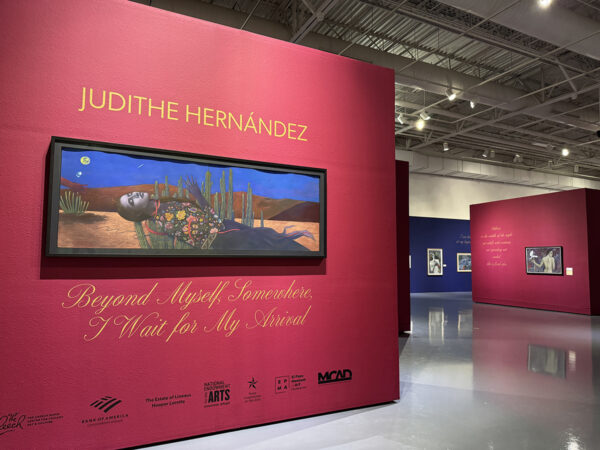
Judithe Hernández: Beyond Myself, Somewhere, I Wait for My Arrival. On view at the El Paso Museum of Art, March 2025.
Though I have visited EPMA before, through the presentation of this exhibition, the mood of the main gallery is markedly different. The darkness of the burgundy and indigo-painted walls makes them appear velvety and creates an environment in which Hernández’ work radiates. Sometimes, the hero image used to promote an exhibition is underwhelming in person, but Hernández’ La Santa Desconocida (The Unknown Saint), placed at the entryway of the exhibition, was as stunning and powerful in person as the web images had implied. A woman’s lifeless body lays against a desert landscape bathed in moonlight. Rather than a grotesque scene, her serene face reflects the brightness of the full moon. A red ribbon extends from an ominous red hand, at the edge of the composition, and wraps around her neck and arm before unfurling across her body and off the page.
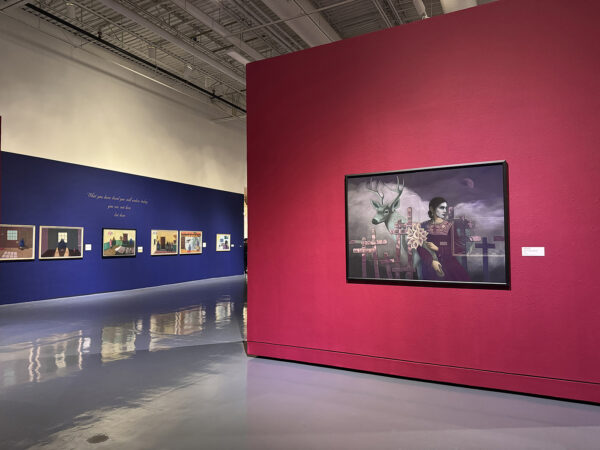
Judithe Hernández: Beyond Myself, Somewhere, I Wait for My Arrival. On view at the El Paso Museum of Art, March 2025.
Death, specifically the murders of women at the U.S.-Mexico border, is a significant theme in Hernández’ work. One could argue that Hernández’ quiet, peaceful depictions of the subject conceal the reality of the violence. However, with the breadth of bloody images available across the internet and news outlets, art need not focus on the explicit brutality enacted on women to properly convey the reality of femicide. Hernández’ work at once bears witness, honors the lives lost, and provides a final moment of tranquility.
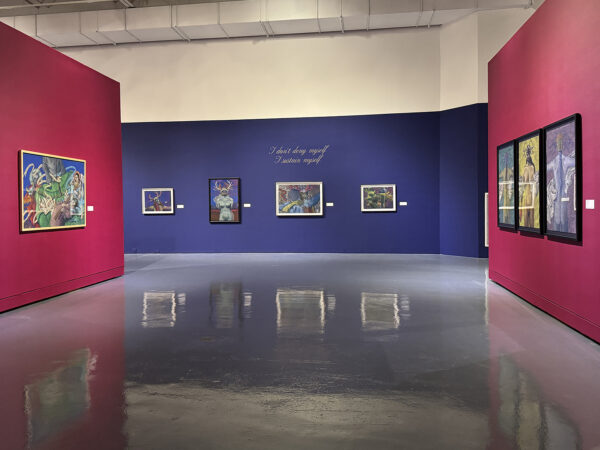
Judithe Hernández: Beyond Myself, Somewhere, I Wait for My Arrival. On view at the El Paso Museum of Art, March 2025.
Across the exhibition, the balance maintained in Hernández’ vivid pastel drawings and mixed-media works, which are simultaneously bold and soft, is echoed in the women who are the subjects of her art. They cannot be easily compressed into a singular stereotype; instead, they contain multitudes. Throughout Hernández’ Adam and Eve Series, Eve is often depicted wearing a luchadora mask with antlers — she is a confident fighter. In The Beginning of Sin, a masked Eve holds Adam in her arms and stares unflinchingly at the viewer, unbothered by the nearby snake inching toward the pair. Eve sustains the same unwavering stare in The Judgement of Eve, in which her body has been pierced by thorns and decapitated. Eve’s facial expression and wounds are reminiscent of Frida Kahlo’s painting depicting herself as a deer pierced by numerous arrows, The Wounded Deer.
Other works by Hernández harken to Kahlo’s imagery steeped in magical realism. A section of the exhibition, titled Surrealist Landscapes, includes dreamlike works created across time and that belong to various series by the artist. These drawings are connected through similar imagery of birds, deer, ribbons, flowers, and architectural elements like windows and checkerboard floors. Included in this section is the titular drawing of the exhibition, named after a line in Octavio Paz’s contemplative poem El Balcón (The Balcony).
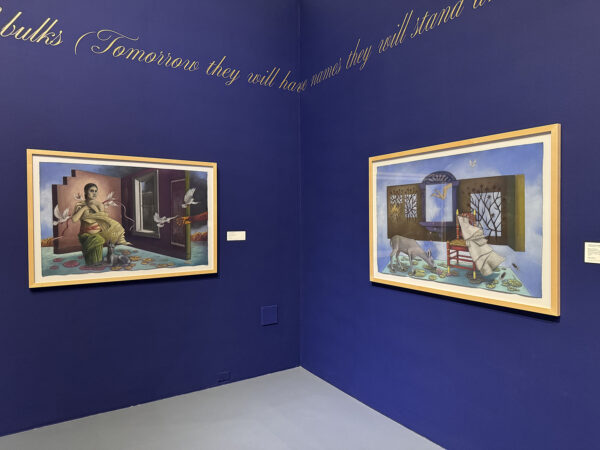
Judithe Hernández: Beyond Myself, Somewhere, I Wait for My Arrival. On view at the El Paso Museum of Art, March 2025.
The drawing, Beyond Myself, Somewhere, I Wait For My Arrival, features a tableau floating in the clouds. A doe stands on a grouping of lily pads floating in a rectangular pond. Nearby, a white dress hangs on a chair, and a pair of white shoes hang in the air, as if they have just been kicked off. In the distance, through a window, the bottom half of a nude woman floats away toward a white dove behind a pillowy cumulus cloud. On the wall, which acts as a barrier between the foreground and background, a small portrait of a woman is engulfed in flames. The work eschews a sense of freedom, the leaving behind of some past, some expectation, some burden that will never again weigh down the distant figure, whose head is literally in the clouds.
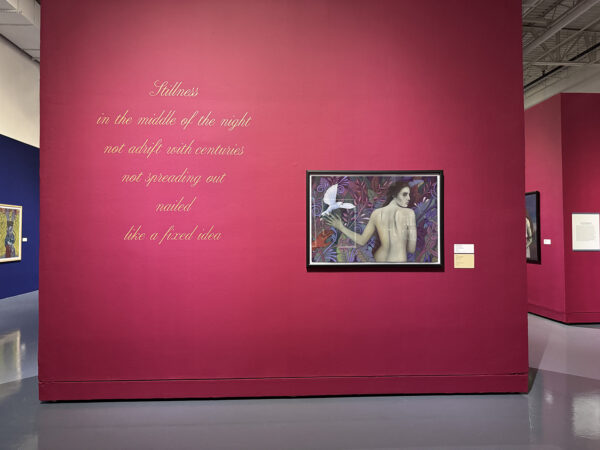
Judithe Hernández: Beyond Myself, Somewhere, I Wait for My Arrival. On view at the El Paso Museum of Art, March 2025.
Phrases from Paz’s poem punctuate the exhibition as large vinyl text unfolding across the walls. The words — which speak to ephemerality, perseverance, and transformation — echo sentiments in Hernández’ work. Beyond Myself, Somewhere, I Wait For My Arrival, the EPMA iteration of the exhibition, features more than 80 works. Together, the pieces cover decades of the artist’s production and present poignant scenes of the complexity of the experience of being a woman, particularly in a patriarchal society.
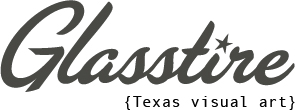


1 comment
Thank you Jessica giving us an inside of Judithe’s exceptional exhibition at the El Paso Museum of Art. It is an exhibition that should not be missed. Thank you Judithe for your powerful work! gaspar